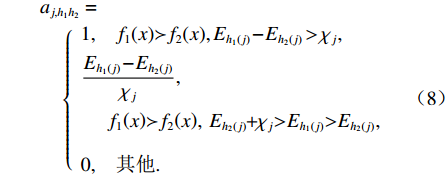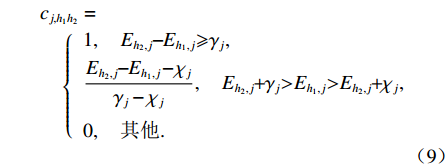Selection in Product Plan Alternatives Based on PPHoQ and Stochastic Variable
-
摘要:
为了以一种有效的方式反映客观环境的复杂性和备选方案工程特性值的分布特征,首先,结合产品规划质量屋(product planning house of quality,PPHoQ)的相关理论,客户代表使用区间型语言短语表征顾客需求的重要性,进而集结顾客需求与工程特性的关联度以及工程特性的自相关度,得到各项工程特性的重要度;其次,通过对备选方案工程特性目标值分布与最优值的差距分析,计算各个备选方案工程特性差距的总体分布期望值;进一步地,引入随机占优度的思想,构建备选方案两两比较的占优度矩阵;最后,依据工程特性的重要度、占优度矩阵和赋值优先关系矩阵,确定各个备选方案的综合评估指数. 将本文方法应用于某颚式破碎机的设计,项目团队确定了该产品的5项顾客需求和5项工程特性,通过基于产品规划质量屋和随机变量的优选方法对拟定的备选方案进行了选择,最终结果验证了所提方法的可行性.
Abstract:To reflect the complexity of real-life situation and to depict the distribution of engineering characteristic (EC) values associated with each alternative in an effective way, firstly, according to the theory of product planning house of quality (PPHoQ), interval linguistic variables are used by the customer representatives to describe their preferences over the customer requirements (CRs). The aggregation of the correlations between CRs and ECs and the autocorrelations of ECs yield the importance degrees of ECs. Secondly, the gaps between the target values and the optimal ones of ECs are analyzed to calculate the expectations of population distributions for alternative plans. Thirdly, the idea of stochastic dominance theory is introduced to construct the dominance matrix via pairwise comparisons between the alternatives. Finally, the comprehensive evaluation indexes of each alternative are determined as per the importance of ECs, the dominance matrix, and the assignment priority matrix. The proposed method is applied in the product development of jaw crushers, in which five CRs and five ECs are determined by the project team, and the alternatives are selected through the house of quality in product plan and stochastic variables. The outcome of the application validates the proposed approach.
-
为了开发满足顾客需求的产品,部分企业在新产品开发过程中引入顾客需求驱动的质量功能配置(quality function deployment, QFD)方法,其基本思想是将顾客反馈的需求信息体现到最终提供的产品中[1]. 产品规划质量屋(product planning house of quality, PPHoQ)是QFD思想发挥作用的基础[2],借助于PPHoQ可以直观地将顾客需求与工程特性之间的关系呈现出来,QFD项目团队通常须依据PPHoQ的输出来设计合理的产品规划方案. 因此,在产品设计的早期,PPHoQ的合理构建和产品规划方案的选择就成为至关重要的环节.
工程特性的重要度分析和最优目标值的配置是PPHoQ的重要输出,对产品规划中后期的顺利进行有着较大的影响[3]. 传统QFD方法采用清晰的分值来表征顾客需求的重要度、顾客需求与工程特性以及工程特性之间的关联强度[4],实际上,决策成员可能为每项评估对象赋予较高分值,这就影响了结论的准确性. 一些研究要求决策成员对各项评估对象进行两两比较[5],进而分析工程特性的重要度,提高了结论的一致性,但是却无法有效处理产品开发早期的不确定性. 因此,文献[6]提出模糊的QFD模型,并构建了PPHoQ的模糊优化方程,文献[7]将模糊理论和传统方法结合,确定工程特性的目标水平.
在规划方案设计早期,决策成员所能掌握的信息是极为有限的,此外,这些信息大都具备不确定性的特点,决策成员更偏好直接使用语言变量来表征自己的偏好信息. 为了充分发挥决策成员的知识和经验,本研究采用基于语言变量和模糊理论的方法分析工程特性的重要度及目标最优值.
PPHoQ的合理构建,有助于QFD项目团队设计体现顾客意见的产品规划方案,在此基础上还须引入先进的理论和方法对备选方案进行选择. 目前,相关的研究成果是比较丰富的,期望效用理论采用冯纽曼-摩根斯坦效用理论对设计者的偏好进行了排序[8];公理设计将信息公理的概念引入产品方案的选择中,基于不同类型属性的期望比较各个备选方案的综合信息量[9].
必须指出的是,上述方法针对的是在使用的过程中权重值和属性值能被清晰确定,但在产品规划方案选择的过程中备选方案工程特性目标值的评价结果可能是随机变量的形式. 实际上,随机多属性决策问题的属性值通常服从正态分布,常用的求解方法有随机支配规则[10]和随机模拟法[11],前者将决策成员分为风险偏好、风险中性和风险厌恶3种类型,处理和计算难度都非常大;而后者得到的结果是在一定置信区间范围内可靠的. 为了有效解决此类问题,本文邀请决策成员对备选方案相互比较,进而结合比较结果的一致矩阵和矛盾矩阵确定各个方案的赋值优先关系,最后通过相关准则的建立得到各个备选方案的排序.
1. QFD理论中PPHoQ的分析
1.1 需求项目和工程特性的确定
企业决策层调集各个相关职能部门的人员组成QFD项目团队,该团队通过多次访谈确定了关键的需求项目集
O={oi|i=1,2,⋯,I} ,即需求项目集有I项需求,oi为第i项需求项目. 基于因果分析,QFD项目团队对产品相关性能技术指标及其参数进行整合分析,确定了该产品的主要工程特性W={wj|j=1,2,⋯,J} ,产品有J项工程特性,wj为第j个工程特性.1.2 顾客需求重要度的确定
客户代表在对各项需求项目判断时,要选择合适的语言评估标度,本文借鉴文献[12]的研究成果,使用以零为中心的非均匀语言评估标度,如式(1)所示.
S={sα|α=−(ε−1),−23(ε−2),⋯,0,⋯,23(ε−2),ε−1}, (1) 式中:
ε 为与所选取的语言评估标度中语言短语个数相关的系数;sα 为客户代表从特定的语言评估标度中表征某项顾客需求重要度的语言短语,通常α 的取值由各位客户代表结合自己的理解程度确定.面对不完全的信息环境,客户代表更偏好于使用语言评估标度中的一个区间来给出偏好信息. 在评估过程中还须集结各位客户的权重系数,得到各项需求重要度的群评估向量为
T=(˜s1,˜s2,⋯,˜sI) .定义1
˜s1=[sα1,sβ1] ,˜s2=[sα2,sβ2] 为两个区间型语言变量,α1 和β1 分别为˜s1 的下限下标和上限下标,α2 和β2 分别为˜s2 的下限下标和上限下标[13]. 设各项需求重要度的可能度矩阵P=(pi1i2)l×l,i1,i2=1,2,⋯,I ,pi1i2 为˜si1⩾ 的概率,如式(2)所示.\begin{split} &{p_{{i_1}{i_2}}} =p\left( {{{\tilde s}_1} \geqslant {{\tilde s}_2}} \right) = \\ & \quad \max \left\{ {1 - \max \left( {\frac{{{\beta _2} - {\alpha _1}}}{{{\beta _1} - {\alpha _1} + {\beta _2} - {\alpha _2}}},0} \right),0} \right\}. \end{split} (2) 最后,基于可能度矩阵,第
{i_1} 项顾客需求的重要度系数为{\rho _{{i_1}}} = \dfrac{{\displaystyle\sum\limits_{{i_1} = 1}^I {{p_{{i_1}{i_2}}}} }}{{\displaystyle\sum\limits_{{i_2} = 1}^I {\displaystyle\sum\limits_{{i_1} = 1}^I {{p_{{i_1}{i_2}}}} } }}. (3) 1.3 顾客需求和工程特性关联矩阵以及工程特性自相关矩阵的确定
顾客需求和工程特性的关联关系也是PPHoQ的关键输入,可以用关联矩阵
{{\boldsymbol{R}}} = {\left( {{r_{ij}}} \right)_{I \times J}} 表示,{r_{ij}} 为一定的技术条件下,工程特性{w_j} 的改进对顾客需求{o_i} 的影响程度. 工程特性自相关矩阵双向反映了工程特性之间的相互影响关系,可以用自相关矩阵{{\boldsymbol{B}}} = {\left( {{b_{{j_1}{j_2}}}} \right)_{J \;\times\; J}} 表示,{b_{{j_1}{j_2}}} 为现有产品线中{w_{{j_1}}} 得到改进对相应特性{w_{{j_2}}} 的贡献程度,{j_1},{j_2} = 1,2, \cdots ,J . 由于QFD项目团队均来自企业内部,对企业的生产情况非常熟悉,采用精确的数值表征关联关系和自相关的偏好信息可以为后续决策提供更有价值的信息.1.4 工程特性重要度的确定
将顾客需求和工程特性的关联矩阵、工程特性的自相关矩阵以及顾客需求的重要度向量集结,得到产品工程特性的重要度向量为
{{\boldsymbol{\xi }}} = {{\boldsymbol{\rho }}} \otimes{\boldsymbol{ R}} \otimes {\boldsymbol{B}} , (4) 式中:
{{\boldsymbol{\rho}} } 为各项顾客需求的重要度向量.进而确定工程特性的重要度系数向量
{{{{\text{ω}}}}} = \left( {{\omega _1},{\omega _2}, \cdots ,{\omega _J}} \right) ,第j项工程特性的重要度系数为{{\boldsymbol{\omega}} _j} = \frac{{{\xi _j}}}{{\displaystyle\sum\limits_{j = 1}^I {{\xi _j}} }}, (5) 式中:
{\xi _j} 为工程特性重要度向量{{\boldsymbol{\xi }}} 中第j个工程特性的重要度.1.5 工程特性最优目标值的确定
为合理确定各项工程特性的实现水平和目标值,本研究使用了较为成熟的基于模糊回归和模糊优化技术的方法[10],以确定研究对象各项工程特性的最优目标值,这里将满足各项工程特性最优值的产品称为“理想产品”.
2. 基于随机多属性决策的方案选择
依据PPHoQ的输出,企业研发设计部门利用自己的工作经验设计了一系列产品规划的初选方案,在此基础上将各个方案的实施结果作逻辑验证,剔除一些满意度水平不高的方案,进而确定了产品规划的备选方案
Y = \left\{ {{{y}_h}\left| {h = 1,2, \cdots ,H} \right.} \right\} ,H为可供选择的备选方案数,{{y}_h} 为第h个备选方案.2.1 各备选方案目标值与最优值的差距分析
首先,在备选方案进行评估前,项目团队根据QFD理论确定各方案的工程特性目标值,然而,这些备选方案是结合产品规划阶段的输出和决策者经验设计的,一般来说,备选方案的工程特性目标值通常是服从正态分布的,QFD项目团队依据企业产品数据库和市场调查的信息,对各个备选方案进行分析,确定了第h个备选方案第j项工程特性目标值的概率密度
{f_{h, j}}\left( x \right) = {\rm{exp}}[ - {(x - {\mu _{h, j}})^2}/ (2\sigma _{h, j}^2)]/ ({{\sqrt {2{\text{π}} } {\sigma _{h, j}}}}) ,其中,{\mu _{h, j}} 和{\sigma _{h, j}} 分别为均值和方差.其次,在方案的选择过程中,依据实际的参数要求,QFD团队将备选方案工程特性目标值与“理想产品”工程特性最优值的差距分为
\zeta 个区间,记为\left\{ {\left( {\lambda _{j, 1,{\rm{L}}}^{},\lambda _{j,1, {\rm{U}}}^{}} \right),\left( {\lambda _{j,2,{\rm{L}}}^{},\lambda _{j,2, {\rm{U}}}^{}} \right), \cdots ,\left( {\lambda _{j,l ,{\rm{L}}}^{},\lambda _{j,l,{\rm{U}}}^{}} \right),\cdots ,\left( {\lambda _{j,\zeta , {\rm{L}}}^{},\lambda _{j,\zeta,{\rm{U}}}^{}} \right)} \right\}. 其中,\lambda _{j,l ,{\rm{L}}}^{} 和\lambda _{j,l,{\rm{U}}}^{} 分别为第j项工程特性第 l 个区间的下限值和上限值. QFD团队对不同区间进行两两比较,得到区间的权重向量{{\boldsymbol{\theta}} } = \left( {{\theta _1},{\theta _2},\cdots ,{\theta _{l} },\cdots ,{\theta _\zeta }} \right) ,其中,{\theta _l} \geqslant 0 ,\displaystyle\sum\limits_{l = 1}^\zeta {{\theta _l}} = 1 ,{\theta _l} 为第l个区间的权重值.再次,备选方案目标值与最优值的差距落在区间
\left( {\lambda _{j,l,{\rm{L}}}^{},\lambda _{j,l,{\rm{U}}}^{}} \right) 内的概率为{P_{h,j,l }} = \int_{\lambda _{j,l,{\rm{L}}}^{}}^{\lambda _{j,l,{\rm{U}}}^{}} {{f_{h, j }}\left( x \right){\rm{d}}x}. (6) 最后,将各区间的权重系数与差距在不同区间的概率集结,得到总体分布的期望值,如式(7)所示.
{E_{h, j }} = \sum\limits_{l = 1}^\zeta {{\theta _l}{P_{h,j,l }}}. (7) 2.2 各备选方案一致矩阵和矛盾矩阵的确定
首先,确定针对工程特性
{w_j} 的随机占优关系矩阵{{\boldsymbol{D}}} = {\left( {d_{j,{h_1}{h_2}}^{}} \right)_{H \times H}} . 其中,d_{j,{h_1}{h_2}}^{} 为针对工程特性{w_j} 第{h_1} 个备选方案和第{h_2} 个备选方案的随机占优关系,h_{1}, h_{2}=1,2, \cdots, H . 判断随机占优关系的定理为定理1 设
{f_1}\left( x \right) = {{\rm{exp}}[{{ - {{\left( {x - {\mu _1}} \right)}^2}}}/({{2\sigma _1^2}})]}/ ({{\sqrt {2{\text{π}} } {\sigma _1}}}) 和{f_2}\left( x \right) = {{\rm{exp}}[{{ - {{\left( {x - {\mu _2}} \right)}^2}}}/({{2\sigma _2^2}})]}/({{\sqrt {2{\text{π}} } {\sigma _2}}}) 为针对工程特性{w_j} 的两个备选方案h1和h2的概率密度函数,{\mu _1} 、{\mu _2} 和{\sigma _1} 、{\sigma _2} 分别为对应的均值和方差,若有{\mu _1} > {\mu _2} ,{\sigma _1} = {\sigma _2} ,则有{f_1}\left( x \right) \succ {f_2}\left( x \right) ,表示{f_1}\left( x \right) 占优于{f_2}\left( x \right) [14].然后,QFD项目团队依据备选方案的实际情况和专业知识,给出第j项工程特性的偏好阈值
{\chi _j} 和否决阈值{\gamma _j} .根据各备选方案关于工程特性总体分布的期望值和偏好阈值,计算备选方案
{y_{{h_1}}} 和备选方案{y_{{h_2}}} 的一致指数{a_{j,{h_1}{h_2}}} ,并构建各备选方案针对工程特性{{\text{w}}_j} 的一致矩阵{{\boldsymbol{A}}} = {\left( {{a_{j,{h_1}{h_2}}}} \right)_{H \times H}} ,{a_{j,{h_1}{h_2}}} 如式(8)所示.\begin{split} &{a}_{j,{h}_{1}{h}_{2}}=\\ &\quad\left\{ \begin{array}{ll}1,\quad {f}_{1} \left(x\right) \succ {f}_{2} \left(x\right) ,{E}_{{h}_{1}\left(j\right)} - {E}_{{h}_{2}\left(j\right)} > {\chi }_{j},\\ \dfrac{{E}_{{h}_{1}\left(j\right)} - {E}_{{h}_{2}\left(j\right)}}{{\chi }_{j}},\\ \quad\;\; {f}_{1} \left(x\right) \succ {f}_{2} \left(x\right) ,\;{E}_{{h}_{2}\left(j\right)} + {\chi }_{j} > {E}_{{h}_{1}\left(j\right)} > {E}_{{h}_{2}\left(j\right)},\\ 0,\quad 其他.\end{array} \right. \end{split} (8) 最后,计算备选方案
{y_{{h_1}}} 和备选方案{y_{{h_2}}} 的矛盾指数{c_{j,{h_1}{h_2}}} ,并构建针对工程特性{{w}_j} 的矛盾矩阵{{\boldsymbol{C}}} = {\left( {{c_{j,{h_1}{h_2}}}} \right)_{H \times H}} ,{c_{j,{h_1}{h_2}}} 如式(9)所示.\begin{split} &{c}_{j,{h}_{1}{h}_{2}}=\\ &\quad\left\{\begin{array}{ll}1,\quad {E}_{{h}_{2},j} - {E}_{{h}_{1},j} \geqslant {\gamma }_{j},\\ \dfrac{{E}_{{h}_{2},j} - {E}_{{h}_{1},j} - {\chi }_{j}}{{\gamma }_{j}-{\chi }_{j}},\quad {E}_{{h}_{2},j} + {\gamma }_{j} > {E}_{{h}_{1},j} > {E}_{{h}_{2},j} + {\chi }_{j},\\ 0,\quad 其他.\end{array}\right. \end{split} (9) 2.3 各备选方案综合评估指数的确定
首先,基于各备选方案关于各项工程特性的一致矩阵
{{\boldsymbol{A}}} = {\left( {{a_{j,{h_1}{h_2}}}} \right)_{H \times H}} ,集结各项工程特性的重要度,以确定备选方案{y_{{h_1}}} 和备选方案{y_{{h_2}}} 之间的总体一致矩阵{{\boldsymbol{G}}} = {\left( {{g_{{h_1}{h_2}}}} \right)_{H \times H}} ,其中,{g_{{h_1}{h_2}}} 为方案{y_{{h_1}}} 偏好于方案{y_{{h_2}}} 的总体一致指数,如式 (10)所示.{g_{{h_1}{h_2}}} = \sum\limits_{j = 1}^J {{\omega _j}{a_{j,{h_1}{h_2}}}}. (10) 其次,依据总体一致矩阵G和矛盾矩阵C,可进一步计算备选方案
{y_{{h_1}}} 偏好于备选方案{y_{{h_2}}} 的赋值优先关系指数{q_{{h_1}{h_2}}} ,据此构建各备选方案的赋值优先关系矩阵{{\boldsymbol{Q}}} = {\left( {{q_{{h_1}{h_2}}}} \right)_{H \times H}} ,{q_{{h_1}{h_2}}} 如式 (11)所示.{q}_{{h}_{1}{h}_{2}}=\left\{\begin{array}{ll}{g}_{{h}_{1}{h}_{2}},\quad \forall j,\;{g}_{{h}_{1}{h}_{2}}\geqslant {c}_{j,{h}_{1}{h}_{2}},\\ {g}_{{h}_{1}{h}_{2}}{\displaystyle \prod _{{c}_{j,{h}_{1}{h}_{2}} > {g}_{{h}_{1}{h}_{2}}}\dfrac{1-{c}_{j,{h}_{1}{h}_{2}}}{1-{g}_{{h}_{1}{h}_{2}}}},\quad 其他.\end{array}\right. (11) 最后,计算综合评估指数
{{V}_h} (式 (12)),并可依据各备选方案的综合评估指数进行排序,从而选择最优的备选方案.{{V}_{{h_1}}} = \sum\limits_{{h_2} = 1}^H {{q_{{h_1}{h_2}}}} . (12) 3. 应用实例
某公司致力于打造成为国内最大的矿山破碎设备制造基地,投资建设现代化的研发中心,尝试将前沿的产品设计方法进行应用. 本研究以高处理能力的PEV 1 000 × 1200颚式破碎机作为验证产品.
3.1 QFD理论中PPHoQ的构建
首先,企业从各部门抽调人员组成QFD项目团队,该团队确定了PPHoQ中的关键需求项目:更高的破碎产量(o1)、更高的设备灵活性(o2)、更好的产品粒度(o3)、更低的运营费用(o4)和更可靠的稳定性(o5). 同时列出了该产品的主要工程特性:最大进料粒度(w1)、排料口调整范围(w2)、生产能力(w3)、电机功率(w4)和整机重量(w5).
其次,客户代表对各项需求项目重要度进行评估,据此构建评估矩阵. 基于加权平均算子将各项需求项目的偏好信息与各位客户代表的影响程度系数集结,得到顾客需求的重要度向量为
\begin{split} &{{\boldsymbol{T}}} = \left( \left[ {{s_{1.17}},{s_{2.72}}} \right],\left [ {{s_{0.50}},{s_{1.61}}} \right],\left[ {{s_{0.26}},{s_{1.30}}} \right],\left[ {{s_{0.09}},{s_{1.11}}} \right], \right.\\ &\left. \quad \left[ {{s_{1.01}},{s_{2.64}}} \right] \right) . \end{split} 通过式(2)确定各项需求重要度的可能度矩阵为
\begin{split} {{\boldsymbol{P}}} = \left[ {\begin{array}{*{20}{c}} {0.500}&{0.835}&{0.950}&{1.000}&{0.538} \\ {0.165}&{0.500}&{0.628}&{0.714}&{0.219} \\ {0.050}&{0.372}&{0.500}&{0.587}&{0.109} \\ {0.000}&{0.286}&{0.413}&{0.500}&{0.038} \\ {0.462}&{0.781}&{0.891}&{0.962}&{0.500} \end{array}} \right] . \end{split} 通过式(3)得到顾客需求的重要度向量为
{{\boldsymbol{\rho}} } = \left( {0.306,0.178,0.129,0.099,0.288} \right) . 再次,QFD项目团队判断顾客需求和工程特性的关联关系以及工程特性的自相关关系,在此基础上,集结不同成员的重要程度得到顾客需求与工程特性的关联矩阵和工程特性的自相关矩阵分别为
\begin{split} &{{\boldsymbol{R}}} = \\ &\quad\left[ {\begin{array}{*{20}{c}} {0.239} & {0.199} & {0.624} & {0.540} & {0.228} \\ {0.397} & {0.466} & { - 0.112} & {0} & {0.357} \\ { - 0.282} & { - 0.302} & {0.386} & {0.318} & {0} \\ {0} & {0} & { - 0.204} & { - 0.412} & { - 0.233} \\ { - 0.113} & { - 0.181} & { - 0.308} & {0} & {0.203} \end{array}} \right] , \end{split} {{\boldsymbol{B}}} = \left[{\begin{array}{*{20}{c}} {1.000}&{0.376}&{0.271}&{0}&{0} \\ {0.145}&{1.000}&{0.346}&{0}&{0.179} \\ {0.108}&{0.313}&{1.000}&{0.468}&{0.361} \\ {0}&{0}&{0.315}&{1.000}&{0.137} \\ {0}&{0.114}&{0.271}&{0.108}&{1.000} \end{array}} \right] . 通过式(4)、(5)得到工程特性重要度系数向量为
{\text{ω}} = \left( {0.128,0.202,0.286,0.196,0.188} \right) . 最后,使用文献[7]中提出的基于模糊回归和模糊优化技术的模型,确定“理想产品”的工程特性最优值,则有
{w_1} = 900 mm,{w_2} = 158 mm,{w_3} = 239 t/h,{w_4} = 132 kW,{w_5} = 51 000 kg.3.2 基于随机决策的产品规划方案选择
研发中心发挥专业的设计经验拟定了一些产品规划方案,在初步验证后进行筛选,最终确定了5个备选方案,分别为y1 ~ y5. QFD项目团队针对各个备选方案的工程特性目标值进行评估,结果如表1所示.
表 1 备选方案目标值与最优值的差距分布Table 1. Gaps between target values and the optimal ones for alternatives备选方案 { w_1} { w_2} { w_3} { w_4} { w_5} {y_1} N\left( {963,{{25}^2}} \right) N\left( {179,{9^2}} \right) N\left( {255,{{12}^2}} \right) N\left( {138,{5^2}} \right) N\left( {51781,{{131}^2}} \right) {y_2} N\left( {936,{{25}^2}} \right) N\left( {164,{9^2}} \right) N\left( {264,{{12}^2}} \right) N\left( {151,{5^2}} \right) N\left( {52149,{{131}^2}} \right) {y_3} N\left( {931,{{25}^2}} \right) N\left( {196,{9^2}} \right) N\left( {252,{{12}^2}} \right) N\left( {159,{5^2}} \right) N\left( {51653,{{131}^2}} \right) {y_4} N\left( {955,{{25}^2}} \right) N\left( {168,{9^2}} \right) N\left( {258,{{12}^2}} \right) N\left( {145,{5^2}} \right) N\left( {51839,{{131}^2}} \right) {y_5} N\left( {991,{{25}^2}} \right) N\left( {173,{9^2}} \right) N\left( {275,{{12}^2}} \right) N\left( {144,{5^2}} \right) N\left( {52096,{{131}^2}} \right) 首先,确定备选方案工程特性目标值与“理想产品”最优值的差距分布矩阵. 并将各项工程特性目标值与最优值的差距分为5个区间,进而使用式(6)得到针对各项工程特性的差距值在各个区间的概率分布,通过式(7)计算各个备选方案的差距值的累积概率分布(表2).
表 2 各个备选方案差距值的累积概率分布Table 2. Cumulative probability distribution of gaps for each alternative期望值 {y_1} {y_2} {y_3} {y_4} {y_5} {E_{h,1}} 0.1557 0.2209 0.2342 0.1723 0.1292 {E_{h,2}} 0.1781 0.2817 0.1121 0.2558 0.2190 {E_{h,3}} 0.2418 0.2058 0.2545 0.2292 0.1659 {E_{h,4}} 0.3004 0.1907 0.1345 0.2211 0.2288 {E_{h,5}} 0.1995 0.1130 0.2173 0.1908 0.1232 其次,基于定理1判断各备选方案关于不同工程特性的随机占优关系,限于篇幅,仅给出针对工程特性 w1的随机占优关系(表3).
表 3 工程特性{w_1} 的随机占优关系Table 3. Stochastic dominance with respect to{{w}_1} 备选方案 {y_1} {y_2} {y_3} {y_4} {y_5} {y_1} - - - \succ {y_2} \succ - \succ \succ {y_3} \succ \succ \succ \succ {y_4} \succ - - \succ {y_5} - - - - 再次,QFD项目团队确定各项工程特性的偏好阈值和否决阈值:
{\chi _1} = 0.05 ,{\gamma _1} = 0.10 ;{\chi _2} = 0.05 ,{\gamma _2} = 0.10 ;{\chi _3} = 0.04 ,{\gamma _3} = 0.09 ;{\chi _4} = 0.05 ,{\gamma _4} = 0.10 ;{\chi _5} = 0.06 ,{\gamma _5} = 0.13 . 依据式(8)和式(9)构建相应的一致矩阵和矛盾矩阵,限于篇幅,仅列出针对工程特性{ w_1} 的一致矩阵和矛盾矩阵分别为{{\boldsymbol{A}}} = \left[ {\begin{array}{*{20}{c}} {0}&{0}&{0}&{0}&{0.530} \\ {1.000}&{0}&{0}&{0.972}&{1.000} \\ {1.000}&{0.266}&{0}&{1.000}&{1.000} \\ {0.332}&{0}&{0}&{0}&{0.862} \\ {0}&{0}&{0}&{0}&{0} \end{array}} \right] \text{,} {{\boldsymbol{C}}} = \left[ {\begin{array}{*{20}{c}} {0}&{0.304}&{0.570}&{0}&{0.530} \\ {0}&{0}&{0}&{0.972}&{1.000} \\ {0}&{0}&{0}&{1.000}&{1.000} \\ {0}&{0}&{0.238}&{0}&{0.862} \\ {0}&{0.834}&{1.000}&{0}&{0} \end{array}} \right] . 通过式(10)得到各备选方案的总体一致矩阵为
{{\boldsymbol{G}}} = \left[ {\begin{array}{*{20}{c}} {0}&{0.641}&{0.398}&{0.313}&{0.693} \\ {0.330}&{0}&{0.398}&{0.229}&{0.615} \\ {0.275}&{0.508}&{0}&{0.392}&{0.602} \\ {0.224}&{0.474}&{0.398}&{0}&{0.733} \\ {0.165}&{0.181}&{0.398}&{0.030}&{0} \end{array}} \right] . 使用式(11)得到各备选方案的赋值优先关系矩阵为
{{\boldsymbol{Q}}} = \left[ {\begin{array}{*{20}{c}} {0}&{0}&{0.284}&{0.203}&{0.693} \\ {0}&{0}&{0.243}&{0.222}&{0.615} \\ {0}&{0}&{0}&{0}&{0} \\ {0.134}&{0.474}&{0.398}&{0}&{0.733} \\ {0.035}&{0.033}&{0}&{0.015}&{0} \end{array}} \right] . 最后,各备选方案的综合评估指数为
{V_1} = 1.180 ,{V_2} = 1.080, {V_3} = 0 ,{V_4} = 1.739 ,{V_5} = 0.083 .据此,备选方案的排序结果为
{y_4} \succ {y_1} \succ {y_2} \succ {y_5} \succ {y_3} . 将该排序结果反馈至企业,最终企业选择了备选方案{y_4} 用于产品的设计和生产阶段.4. 比较分析
为便于比较分析,本文使用文献[9]的公理设计方法对应用实例进行分析,该方法的步骤如下:
步骤1 构建PPHoQ,据此确定各项工程特性的重要度,进而得到相应的期望范围;
步骤2 确定产品规划备选方案各项工程特性的期望范围;
步骤3 获取期望范围和最优值的差值,得到各个备选方案的期望符合程度;
步骤4 确定产品规划备选方案在各项工程特性上的信息量(表4);
步骤5 计算各个备选方案的综合信息量,并据此选择最优方案.
表 4 产品规划备选方案在各项工程特性上的信息量Table 4. Information contents of alternatives with respect to engineering characterisic备选方案 { w_1} { w_2} { w_3} { w_4} { w_5} {y_1} 0.171 - 0.126 - - {y_2} - - 0.167 - - {y_3} - - \infty - - {y_4} 0.175 - 0.143 - - {y_5} 0.132 - \infty - - 可以看出,备选方案y3和y5在工程特性 w3的信息量为
\infty ,依据公理设计的原理,须剔除.剩余备选方案的综合信息量排序为
{y_4} \succ {y_1} \succ {y_2} . 与本文所提方法的结论存在部分差异,主要原因为:1) 与公理设计理论中工程特性存在期望范围的假设不同,本文考虑项目团队往往参照理想点的特征,这使得两种方法实际处理的数据对象和范围发生了变化. 2) 基于公理设计的决策方法通过两次信息形式的转化得到了相应的结果,分别是将语言变量转化为模糊数和将模糊数转化为清晰值,不可避免带来决策信息的丢失;相较于此,本文更充分地利用了决策者给出的偏好信息,排序结果也更好地体现了方案之间存在的差异. 3) 相较于公理设计中工程特性期望范围的评估信息,本文所提方法使用基于正态分布的随机占优决策方法更为真实和全面地体现了决策者信息的特征,得到的结果也更加符合现实情况.5. 结论及展望
1) 基于更符合真实情况的语言短语和改进的模糊优化技术,实现不确定环境下工程特性重要度和目标值的深入分析.
2) 通过面向正态分布的随机多属性决策理论,系统分析工程特性目标值与最优值的差距以及各个备选方案的随机占优关系,能快速而准确地确定产品规划的最优方案.
3) 下一步将对PPHoQ的动态分析以及不同分布特征的随机优化方法展开研究.
-
表 1 备选方案目标值与最优值的差距分布
Table 1. Gaps between target values and the optimal ones for alternatives
备选方案 { w_1} { w_2} { w_3} { w_4} { w_5} {y_1} N\left( {963,{{25}^2}} \right) N\left( {179,{9^2}} \right) N\left( {255,{{12}^2}} \right) N\left( {138,{5^2}} \right) N\left( {51781,{{131}^2}} \right) {y_2} N\left( {936,{{25}^2}} \right) N\left( {164,{9^2}} \right) N\left( {264,{{12}^2}} \right) N\left( {151,{5^2}} \right) N\left( {52149,{{131}^2}} \right) {y_3} N\left( {931,{{25}^2}} \right) N\left( {196,{9^2}} \right) N\left( {252,{{12}^2}} \right) N\left( {159,{5^2}} \right) N\left( {51653,{{131}^2}} \right) {y_4} N\left( {955,{{25}^2}} \right) N\left( {168,{9^2}} \right) N\left( {258,{{12}^2}} \right) N\left( {145,{5^2}} \right) N\left( {51839,{{131}^2}} \right) {y_5} N\left( {991,{{25}^2}} \right) N\left( {173,{9^2}} \right) N\left( {275,{{12}^2}} \right) N\left( {144,{5^2}} \right) N\left( {52096,{{131}^2}} \right) 表 2 各个备选方案差距值的累积概率分布
Table 2. Cumulative probability distribution of gaps for each alternative
期望值 {y_1} {y_2} {y_3} {y_4} {y_5} {E_{h,1}} 0.1557 0.2209 0.2342 0.1723 0.1292 {E_{h,2}} 0.1781 0.2817 0.1121 0.2558 0.2190 {E_{h,3}} 0.2418 0.2058 0.2545 0.2292 0.1659 {E_{h,4}} 0.3004 0.1907 0.1345 0.2211 0.2288 {E_{h,5}} 0.1995 0.1130 0.2173 0.1908 0.1232 表 3 工程特性
{w_1} 的随机占优关系Table 3. Stochastic dominance with respect to
{{w}_1} 备选方案 {y_1} {y_2} {y_3} {y_4} {y_5} {y_1} - - - \succ {y_2} \succ - \succ \succ {y_3} \succ \succ \succ \succ {y_4} \succ - - \succ {y_5} - - - - 表 4 产品规划备选方案在各项工程特性上的信息量
Table 4. Information contents of alternatives with respect to engineering characterisic
备选方案 { w_1} { w_2} { w_3} { w_4} { w_5} {y_1} 0.171 - 0.126 - - {y_2} - - 0.167 - - {y_3} - - \infty - - {y_4} 0.175 - 0.143 - - {y_5} 0.132 - \infty - - -
[1] KAGAN E, LEIDER S, LOVEJOY W S. Ideation—execution transition in product development:an experimental analysis[J]. Management Science, 2018, 64(5): 2238-2262. doi: 10.1287/mnsc.2016.2709 [2] ALBRITTON M D, MCMULLEN P R. Optimal product design using a colony of virtual ants[J]. European Journal of Operational Research, 2007, 176(1): 498-520. doi: 10.1016/j.ejor.2005.06.042 [3] 陈以增,于齐. 基于博弈论的顾客需求权重确定方法[J]. 系统管理学报,2017,26(1): 196-199.CHEN Yizeng, YU Qi. A game thory-based approach to determining the weights of customer requirements[J]. Journal of Systems & Management, 2017, 26(1): 196-199. [4] CHAN L K, WU M L. A systematic approach to quality function deployment with a full illustrative example[J]. Omega, 2005, 33(2): 119-139. doi: 10.1016/j.omega.2004.03.010 [5] 耿秀丽,潘亚虹. 考虑用户体验的产品服务系统模块重要度判定方法[J]. 计算机集成制造系统,2020,26(5): 1295-1303.GENG Xiuli, PAN Yahong. Importance degree determination approach for product service system modules based on user experience[J]. Computer Integrated Manufacturing Systems, 2020, 26(5): 1295-1303. [6] LI Y L, DU Y F, CHIN K S. Determining the importance ratings of customer requirements in quality function deployment based on interval linguistic information[J]. International Journal of Production Research, 2018, 56(14): 4692-4708. doi: 10.1080/00207543.2017.1417650 [7] LUO X G, KWONG C K, TANG J F. Determining optimal levels of engineering characteristics in quality function deployment under multi-segment market[J]. Computers & Industrial Engineering, 2010, 59(1): 126-135. [8] BUTLER J, MORRICE D J, MULLARKEY P W. A multiple attribute utility theory approach to ranking and selection[J]. Management Science, 2001, 47(6): 800-816. doi: 10.1287/mnsc.47.6.800.9812 [9] KULAK O, KAHRAMAN C. Fuzzy multi-attribute selection among transportation companies using axiomatic design and analytic hierarchy process[J]. Information Sciences, 2005, 170(2/3/4): 191-210. [10] CHEN Z H, MING X G, WANG R C, et al. Selection of design alternatives for smart product service system: a rough-fuzzy data envelopment analysis approach[J]. Journal of Cleaner Production, 2020, 273: 122931.1-122931.19. doi: 10.1016/j.jclepro.2020.122931 [11] LAHDELMA R, SALMINEN P. Stochastic multicriteria acceptability analysis using the data envelopment model[J]. European Journal of Operational Research, 2006, 170(1): 241-252. doi: 10.1016/j.ejor.2004.07.040 [12] XU Z S. An interactive approach to multiple attribute group decision making with multigranular uncertain linguistic information[J]. Group Decision and Negotiation, 2009, 18(2): 119-145. doi: 10.1007/s10726-008-9131-0 [13] ZHAO N, XU Z S. Prioritized dual hesitant fuzzy aggregation operators based on t-norms and t-conorms with their applications in decision making[J]. Informatica, 2018, 29(3): 581-607. doi: 10.15388/Informatica.2018.183 [14] GASTELUM CHAVIRA D A, LEYVA LOPEZ J C, SOLANO NORIEGA J J, et al. A credit ranking model for a parafinancial company based on the ELECTRE-Ⅲ method and a multiobjective evolutionary algorithm[J]. Applied Soft Computing, 2017, 60: 190-201. doi: 10.1016/j.asoc.2017.06.021 期刊类型引用(0)
其他类型引用(2)
-

 点击查看大图
点击查看大图
计量
- 文章访问数: 351
- HTML全文浏览量: 176
- PDF下载量: 12
- 被引次数: 2






















































































































 下载:
下载:


























 下载:
下载: 

